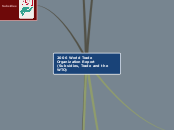2006 World Trade Organization Report (Subsidies, Trade and the WTO)

The Economy had a lower growth in 2005

UE largest economies below 2%

Lower percentage

UE destinations

Trade in Textiles and Clothing

The expiry of the agreement
Causing
Replacement of domestic production by suppliers from lower income countries
Production declines
The importance of Developed countries' market decrease.
Growing importance of developing countries
Ex: China

Lack of diversfications

Royalties and Fee Payments

faster than commercial services

Are among affiliated companies
causing
Countries remain dominant in receipts and payments
East Asian economies got strong
High level of foreign Investment
Singapour, China, and the Republic of Korea

Increased loyalties and fee payments

due to
High oil prices
Slacking of product capacity
Increased wage
Increased demand of
Time investment
Oil exporters invest more in goods than before
Investments in liquid assets
but in US bonds

Consequences
Decreased od US & Euro
Japan stagnated
US dollar appreciation
improve its deficit
Low inflation growth
Reduced oil consumption of OCDE countries
Optimization of the energy
Less than the preceding years

The impact of natural disasters
Could be
Notable
Considerable (in somes industries)
Depends on how
How tradable is the devasted sector
How integrated it is in the global economy
Consequences
National level
Macroecnomic activity weakens
Tourism is not affected
Sri Lanka Tsunami in December 2004
International arena
Exports fall
Lack of production
Important inputs may be short
Major utilities may be disrupt
Transportation bottlenecks
Imports rise
Foreign goods or services

Terrorist Attacks
Effects
Localized and temporary
The costs may rise
Some industries may be affected
Tightened security

Why Governments Subsidize

Industrial Development
To develope industries
Agriculture
Services
State intervention
Control that the diserable investments are made
Could lead to market failure
Could not be as efficient as it should

Production of Knowledge goods

State promotes Development and Research
Benefical on a social perspective
The government will need to invest in more resources
Intelectual Property Systems

Strategic Trade Policy

Secure national advantage in economies of scale
R&D intensive industries
Risk of dissipate funds
Hurtful for active partners

Distribution

To change the distribution of income in societies
for equality
on agriculture

Environmental Protection
also with regulations, laws, tariffs, taxes
Useful for
Facilitate adjustments of new environmental regulations
Correct asymmentries
Others
National security
Food
Energy
Non- trade concerns
Agriculture
Increasing commodities production
Non- commodities
Cultural heritage
Trade liberalization erodes national identity (subsidies helf not to)
Bibliography
Thornton, R. (12 oct 2015). What are Subsidies? Retrieved from: https://www.youtube.com/watch?v=EhvimG6kSa0
Learn Liberty. (28 ene 2015). Should We Subsidize Scientific Research? Retrieved from: https://www.youtube.com/watch?v=ozJHw9NrK4E
WTO. (2006). World Trade Report 2006 Exploring the links between subsidies, trade and the WTO. Retrieved from: https://www.wto.org/english/res_e/booksp_e/anrep_e/world_trade_report06_e.pdf
Incidence

In

Agriculture

Welfare loss
Providers

Distortion
Importers
Exporters
AMS
Domestic support

Reduction of commitments

Trade distorting
Minimis levels
UE, US, JAPAN
Distribution by commodities
Export subsidies
Export subsidies
Notifiable
Non- notifiable
Export credit, guarantees
State- trading enterprises (market power)
Price discrimination
Privilage
Food aid

Services
Measures
Developed
Grants
Developing
Tax incentives

Transport
Universal Access
Environmental
Railway
Security

Telecommunications
Universal Service
Universal Service Funds
Developing
Availability
Developed
Affordability

Financial Service
Objectives
Keep banks afloat
Restructure
Equity injections
Tax Incentives

Tourism
Developed
Marketing Support SME
Developing
Infrastructure

Audiovisual
Promotion domestic content
Cultural objectives (policy instruments)

Industry
Subsidies & GDP

Horizontal (fiscal incentives, policies, EPZs)
Latinamerica
The Caribbean

Specific
Automotive indsutry

Recipients
Minning, steel, forestry
Coal
development, energy security
restructing
Fishing

Stable subsidies

Objectives
Substainability
Development
Income support
Environmental
Protection
Subsidies


Incidence (overview)

Countries
Developed Subsidies
Developing Subsidies

Variation in sectorial distribution

Hard to find comprehensive information

International Data
Cross country comparability

Limited number of sectors

Addtional Sources
Reports
National
Notifications
WTO
Requirements
Information

Reasons
Who

Policy objectives

Theory

Correct market failure

International Perspective

Competitive threat
Severe effects
Nullify national welfare

WTO rules
Subsidies
Non- disruptive

Economic Analysis
Why
Desirability
Merits

Aware of the costs

Definition

Unrequited transfer
WTO agreement
Forms of subsidy
Specificity

Distinguish the recipients
subsidies
specific
general
also
Subtema

Budgetary outlays

Provision of goods and services

Affectation of prices

Subsidies and the WTO
Subsidies to manufactured exports in developing countries

Increase welfare
Infant Marketing
Export processing zones
Job, income, skills
Funtional policies
Permissive policies
Protectionist bias

Distortion
Nullifying remedial actions
Subsidy competition
Evolution of rules
Consultation
Exports Subsidies
Agricultural products
Tokyo Round Agreement
Countervailing duties
Non- agricultural goods
Uruguay Roun Agreement
Definition of subsidies
Concept of specificity
Differential treatment
Anti- subsidy remedies
Unilateral
Countervailing duties

Consumer

Producer
Multilateral
Dispute settlement
Agreement on Agriculture
Different rules (reduction commitment)
Domestic support
Export subsidies
Special treatment
Lesser (liberalization)
Higher de minimis thresholds
General Agreement on Trade in Services
Disciplines
Use of diseminatory subsidies
Negotiation mandate
The Doha Development Agenda

Andrea Romero and Angie Yépez
Export promotion policies vs Import Substitution Policies
Export Promotion Policies
Countries with comparative advantages are better
Import Substitution Policies
Cost of subsidies are more transparent than tarifs
